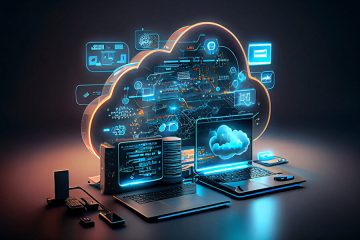这门课的老师很牛逼,北大博士,并且发表了多篇优秀的论文。但是一个好的researcher不等于好的teacher。这位大哥的中式英文口音太重了,偶尔还冒出来几个中文,但是不影响理解。课程内容还是偏向于传统的念PPT,至少第一节课概念性的东西太多,并且有一些是多次重复。
先说一下作业部分,分为两块,一个是团队作业做一个小project,占比50%。另外一个是期末的开卷考试。
1. Introduction to Cloud Computing
2. Cloud and Distributed Computing Infrastructure
3. Cloud Web Service Protocols
4. Lab: Amazon Web Services
5. Complex Networks and the Cloud
6. Cloud Resource Virtualization
7. Cloud Service Workflow Management: BPMN and Petri Nets
8. Lab: Developing BPMN and Petri Nets Processes
9. Intelligence in the Cloud: Semantic Web, knowledge graph,
Graph representation learning and Recommender Systems
10. Containerization and Security in the Cloud (Guest Lecture)
这节课安排如上,外加第11周的讲PPT,以及第12周的考试。
第一周主要介绍了cloud computing的一些概念,优缺点等等,最后一小块听得有点迷糊。其他部分都可以。
云计算的概念:可以简单理解为一种服务,通过网络可以给用户提供各种工具,应用,储存等等资源。
Cloud computing is the on-demand availability of computer system resources, especially data storage (cloud storage) and computing power, without direct active management by the user. Large clouds often have functions distributed over multiple locations, each of which is a data center. Cloud computing relies on sharing of resources to achieve coherence and typically uses a "pay as you go" model, which can help in reducing capital expenses but may also lead to unexpected operating expenses for users.
这里搞清楚服务和产品的区别,购买一个产品比如买一个储存的东西,得买一个硬盘,那么这个硬盘的拥有权则隶属于用户。而服务则不一样,用户购买一个储存的服务比如onedrive,并不拥有供应商手中的那个储存设备,只是可以使用,更加像租赁。这两个都各有优劣。但是相对来说,服务的价格更低,因为不用考虑产品的贬值,损耗等等。
例子:一些银行使用云计算后,成本下降了非常多,因为不用买大量的硬件,不用支付大量的电费,场地费,网费,人工维护成本等等。
下图则展示了云计算的发展历程。

其中Grid computing 很少见,一般用于科学计算之类的,而且采用分布式架构,下图可以看到Grid 和Cloud的区别。

然后简单介绍了云计算的属性,模式,资源等等,基本就是下面的几个话题
公有云,自由云,混合云等等,话说云计算的很大一个基础就是虚拟机。

Cloud Computing Advantages 云计算的优点基本也是翻来覆去的
1. Resources, such as CPU cycles, storage, network bandwidth, are shared.
2. When multiple applications share a system, their peak demands for resources are not synchronised thus, multiplexing leads to a higher resource utilization.
3. Resources can be aggregated to support data-intensive applications.
4. Data sharing facilitates collaborative activities. Many applications require multiple types of analysis of shared data sets and multiple decisions carried out by groups scattered around the globe.
5. Eliminates the initial investment costs for a private computing infrastructure and the maintenance and operation costs.
6. Cost reduction: concentration of resources creates the opportunity to pay as you go for computing.
7. Elasticity: the ability to accommodate workloads with very large peak-to-average ratios.
8. User convenience: virtualization allows users to operate in familiar environments rather than in idiosyncratic ones.
比较老生常谈的模式,SaaS,PaaS,IaaS,

再然后讲了虚拟机的一些基础,也都是一些概念性的东西。

再后来讲了web的一些东西,
What are Web Services?
W3C definition:
• [a Web service] has an interface described in a machine- processable format (specifically WSDL). Other systems interact with the Web service in a manner prescribed by its description using SOAP (Simple Object Access Protocol) messages, typically conveyed using HTTP with an XML serialization in conjunction with other Web-related standards.
• REST-compliant Web services, in which the primary purpose of the service is to manipulate representations of Web resources using a uniform set of stateless operations.

Where to find web services? 给了一些网站,可以利用他们的API,这里主要是讲了云服务在web这一块的应用。但是我看了看只有最后一个可以打开
• http://www.programmableweb.com/
• http://www.apiforthat.com/
• https://www.publicapis.com/
• http://apis.io/

最后这一段我没听懂的是WEB2.0

以及最后几个公式,老师也是一笔带过,没怎么细讲


所以基本内容不多,主要看看阅读材料,有一本书前两章就是该课程的内容。公式也写的很详细。
第一章还是概念的东西居多,讲了Cloud的起源,这里突然出现了thick 和thin client的概念,突然回忆起来10年前在华为的时候,有瘦客户机的概念,我当时一直没懂这是啥。现在搞懂了这两者都是CS架构,但是thin的资源都放在S端,而thick的放在C端也就是本地端。
第二章就出现了公式,但是各个版本的书籍不一样,结果我问了老师,老实说随便看看就行
